Micro-influencers are becoming key players in influencer marketing with their 10K to 100K followers. Unlike celebrity influencers, they build niche communities, offer authentic engagement, and often outperform bigger names when it comes to ROI.
In fact, micro-influencers generate up to 60% more engagement than macro-influencers. As more brands shift toward meaningful, ROI-driven marketing, tracking the performance of influencer collaborations has become essential.
That’s where a performance marketing platform like Trackier becomes invaluable, helping you attribute results, analyze engagement, and optimize campaigns in real time.
What is a Micro-Influencer?
Micro-influencers are people who create content on social media and have between 10,000 and 100,000 followers.
They’re different from big-name influencers or celebrities with huge audiences because they focus on specific topics like beauty, fitness, travel, or tech, and they connect with smaller groups who really care about those topics.
Here’s how influencers are grouped by follower numbers:
- Nano-influencers: 1,000 to 10,000 followers
- Micro-influencers: 10,000 to 100,000 followers
- Macro-influencers: 100,000 to 1 million followers
- Mega or celebrity influencers: More than 1 million followers
Even though micro-influencers don’t have as many followers, they often get more likes, comments, and shares than bigger influencers.
Their fans find them easier to relate to and trust, which leads to real conversations and a stronger influence. This genuine connection makes them great for brands trying to reach specific groups of audiences.
Benefits of Collaborating with Micro-Influencers
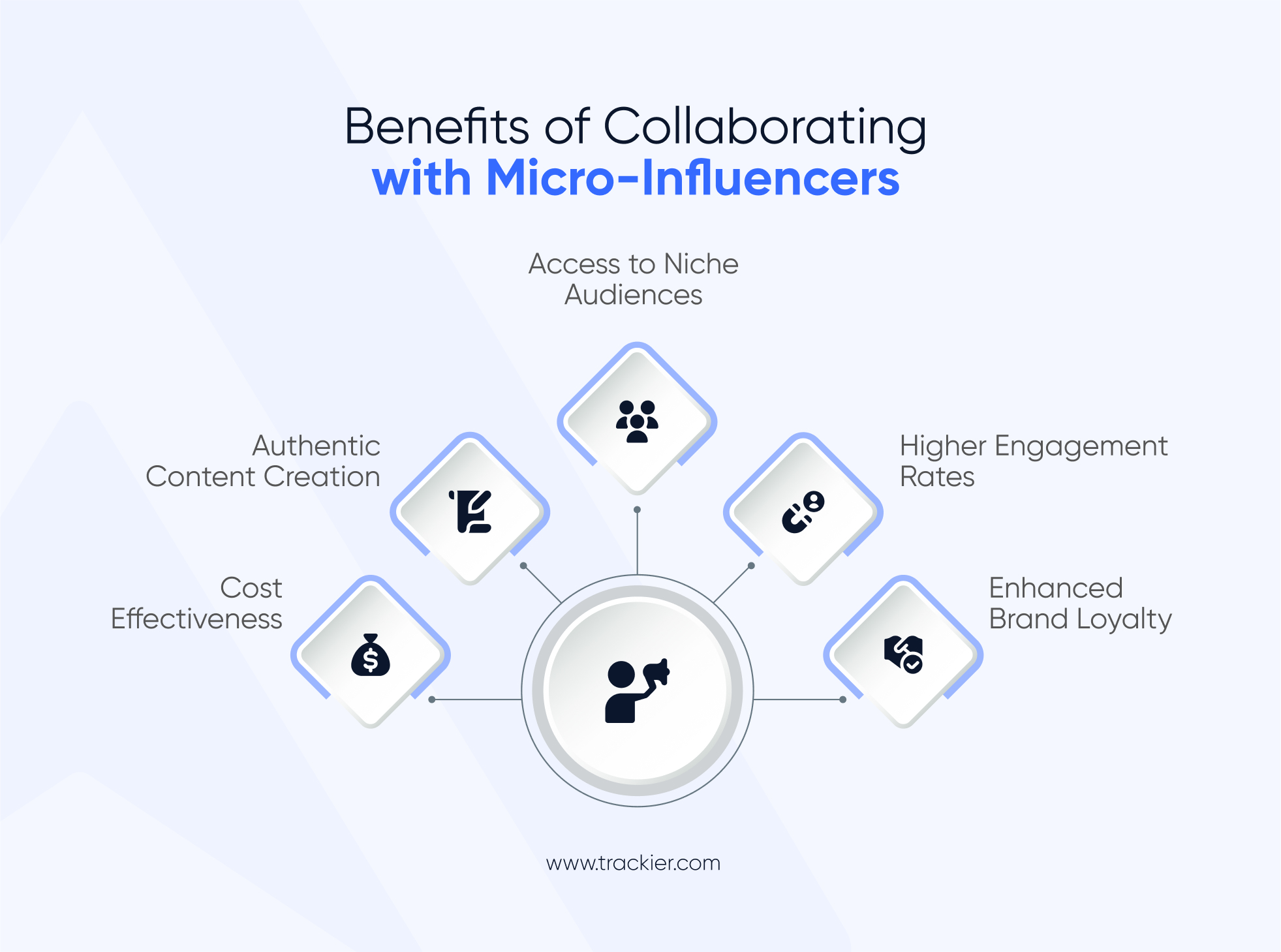
Collaborating with micro-influencers offers many advantages for brands aiming to enhance their marketing efforts. Key benefits include:
- Cost-Effectiveness: Partnering with micro-influencers is cost-effective and more budget-friendly, as brands do not have to spend huge marketing budgets. Collaboration rates of micro-influencers are generally lower, which brands can leverage to allocate their marketing budget effectively and get higher ROI.
- Authentic Content Creation: Micro-influencers are known for producing genuine and relatable content that resonates with their audiences. Their endorsements often come across as recommendations rather than advertisements that build trust and increase credibility among followers.
- Access to Niche Audiences: Many micro-influencers focus on specific interests or industries that brands leverage to reach their targeted demographics. This specialization ensures that promotional content is delivered to an audience already interested in the particular niche, which increases the chances of engagement and conversion.
- Higher Engagement Rates: Due to their smaller and more dedicated follower base, micro-influencers often experience higher engagement rates compared to big influencers. This increased interaction can lead to more meaningful connections.
- Enhanced Brand Loyalty: Nowadays, there are so many brands available in every niche. So, to differentiate yourself, you can collaborate with micro-influencers to build strong brand loyalty.
How to Find the Right Micro-Influencers?
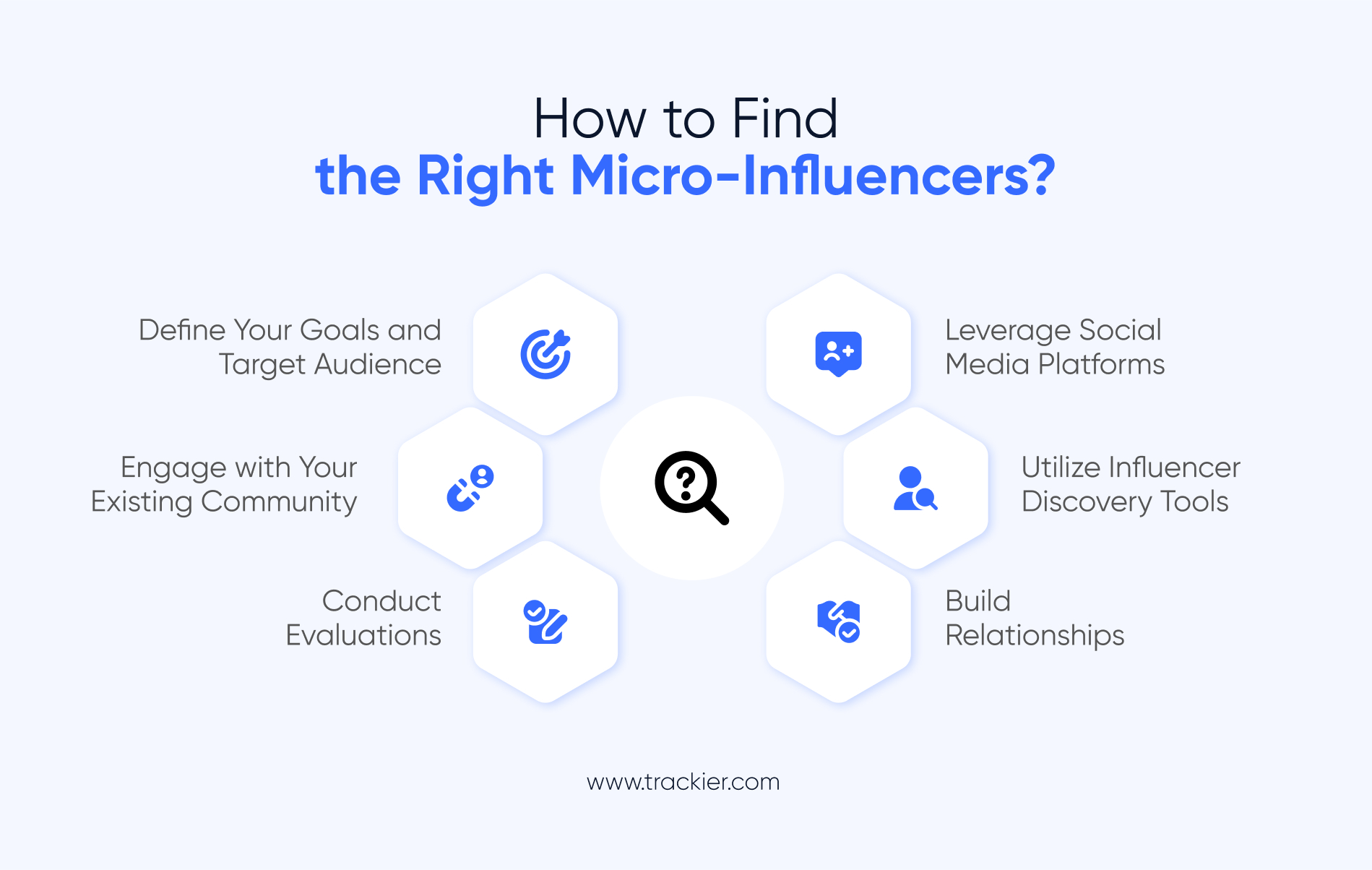
Identifying the right micro-influencers is crucial for the success of your marketing campaigns. Here’s a structured approach to help you find those that align with your brand:
- Define Your Goals and Target Audience: Determine what you aim to achieve through influencer collaborations, such as increasing brand awareness, driving sales, or entering new markets. Also, identify the demographics, audience profile, interests, and behaviors of your target market to ensure alignment with the influencer’s followers.
- Leverage Social Media Platforms: Utilize relevant hashtags to discover influencers within your niche. For instance, searching for #skincaretips can help you discover beauty influencers. Other than this, you can leverage the ‘Explore’ or ‘For You’ pages on social media platforms to find trending content creators related to your industry.
- Engage with Your Existing Community: Look among your current followers and customers for individuals who are already promoting your products or services. These organic individuals can be valuable micro-influencers. However, keep track of users who tag your brand or mention it in their content, as they may be interested in collaborations.
- Utilize Influencer Discovery Tools: Leverage some of the influencer discovery tools to connect with influencers who fit your brand’s criteria. These platforms offer filters to narrow down searches based on niche, location, and engagement rates.
- Conduct Evaluations: Assess the influencer’s content to ensure it aligns with your brand’s values and aesthetic. Analyze engagement rates, such as likes, comments, and shares, to identify the influencer’s ability to connect with their audience. Also, verify that the influencer’s followers are genuine and not artificially inflated.
- Build Relationships: Before contacting potential influencers, create a personalized message that should showcase a genuine intent for collaboration. If you are connecting over e-mail, craft everything that they need to know, like the terms and conditions, payouts, and everything.
How to Measure the Impact of Micro-Influencers?

Brands need to measure the impact of their collaborations with micro-influencers to identify if they are giving the ROI or not. If yes, then they need to optimize future marketing strategies.
By focusing on important KPIs (key performance indicators) and utilizing Trackier (a performance marketing software) to gain real-time insights and performance of their influencers. Here is a simple way to measure the impact:
Define Clear Objectives
Identify what you want to do by partnering with micro-influencers for campaigns. The reasons can be so many, including:
- Increasing brand awareness
- Driving website traffic
- Boosting sales
So, first, clear your objectives that will help you in the selection of effective KPIs.
Monitor Engagement Metrics
Identify various metrics on the content of micro-influencers, such as likes, comments, shares, and saves, to assess their audience engagement. (It will help you to identify if that influencer can give the highest ROI or not.)
High engagement rates often indicate that audiences are resonant and engaging with their content.
Measure Reach and Impressions
Analyze the number of unique viewers (reach) and total views (impressions) of the influencer’s content to understand its exposure level.
Utilize Trackable Links and Promo Codes
Assign specific tracking links or discount codes to each influencer to monitor direct traffic and sales generated from their content. This approach facilitates the precise attribution of conversions.
Analyze Conversion Rates
Asses the percentage of the influencer’s audience that completes specific actions including:
- Making a purchase
- Signing up for a newsletter
These stats will help you to identify the campaign’s success in driving conversions.
Calculate Return on Investment (ROI)
To identify the ROI, compare the revenue generated from the influencer campaign against the associated costs to evaluate profitability and inform future budget allocations.
Leverage Advanced Tracking Tools
Utilize platforms like Trackier to streamline the measurement process. Trackier offers detailed insights into engagement, conversions, and ROI that help brand to optimize their micro-influencer marketing strategies effectively.
How Leading Brands Succeed with Micro-Influencers?
Many brands have leveraged the power of micro-influencers to enhance their marketing strategies. Here are some of the best examples:
1. Banana Republic

Banana Republic is a great example of a brand using Instagram fashion and lifestyle micro-influencers. They’ve run 13 campaigns so far, reaching a total of 43.2 million people.
In these partnerships, influencers wear the brand’s seasonal clothes in different places, showing off how versatile Banana Republic’s style can be.
2. Coca-Cola
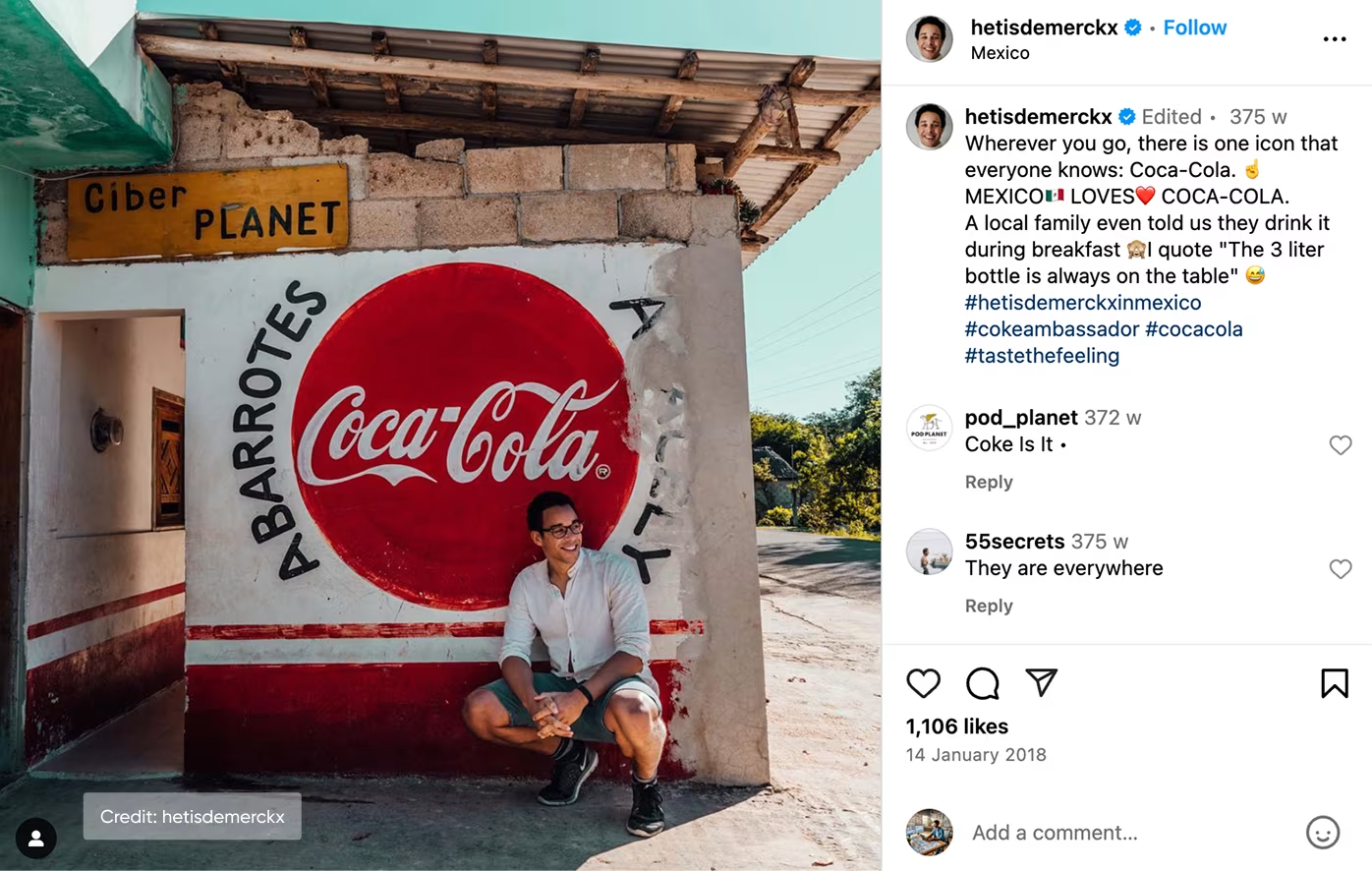
You wouldn’t think a huge company like Coca-Cola would bother with micro-influencers, but they did in Belgium. They teamed up with 14 Instagram users, including Miette Dierckx and Yannick Merckx, many with fewer than 100,000 followers.
Focusing on areas like travel, food, sports, and fashion, the campaign showed real, everyday moments of people enjoying Coca-Cola. It helped the brand feel more down-to-earth and connect with people across Europe.
3. Sperry
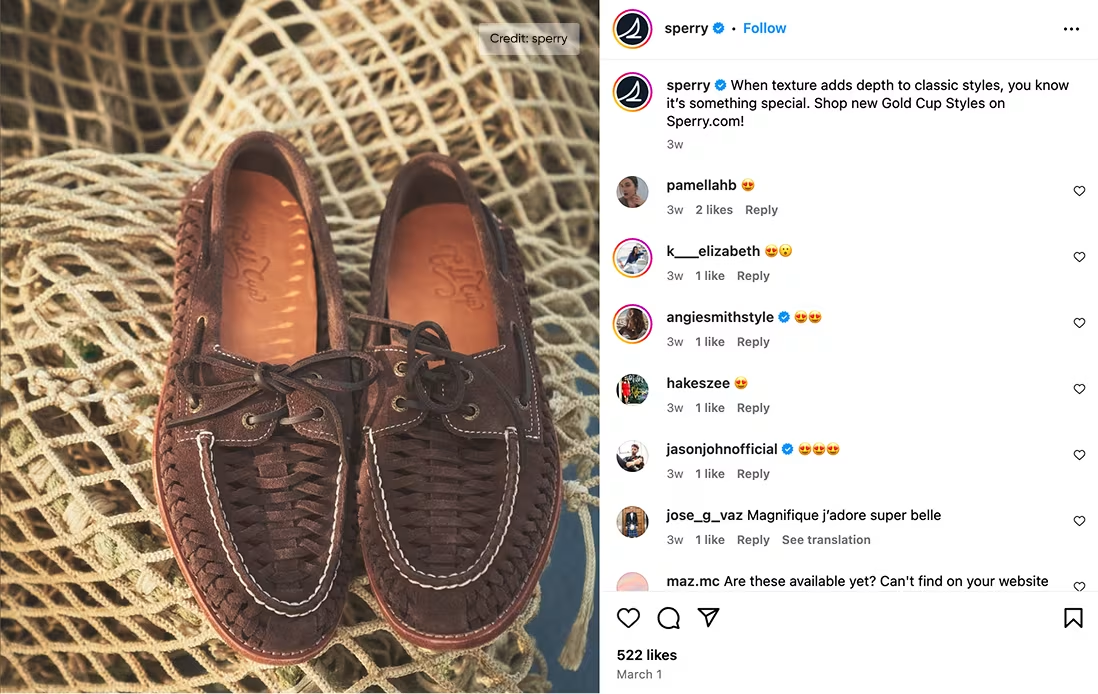
Sperry, a brand known for boat shoes, was one of the first to use micro-influencers. In their 2016-17 rainy season campaign, they teamed up with 100 Instagram users who already owned and liked their shoes.
This real-deal strategy got over 4.7 million views and boosted their website traffic by 66%. It proved that showing everyday people using practical, stylish items like waterproof shoes can beat celebrity ads, especially when tied to trendy hashtags like #OOTD.
4. Audible
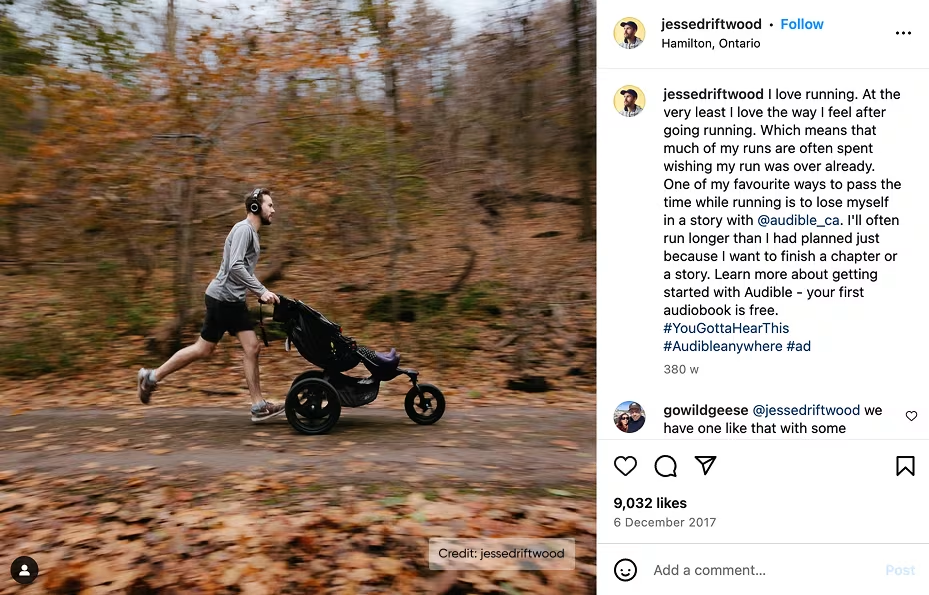
Audible, Amazon’s audiobook service, often sponsors big YouTubers but also works with micro-influencers to grow its reach beyond YouTube.
For instance, photographer Jesse Driftwood shared a simple Instagram post about listening to audiobooks while running, making it feel like a casual tip from a friend instead of a pushy ad.
Audible lets these smaller influencers get creative with how they promote, which is a clever way to spread the word about the brand.
5. Gillette

Gillette wanted to reach Gen Z with its Venus line, so they partnered with female beauty influencers, including nano-influencers who have fewer than 1,000 followers.
For the #ChooseToSmooth campaign, they sent out “Influenster” boxes to these influencers, encouraging them to create real, everyday content, often filmed in normal bathrooms you’d find in any home. The campaign connected with over 476,000 people and got a 2.2% engagement rate, showing how effective, honest, and relatable influencer posts can be.
Conclusion
In conclusion, in the crowded world of digital marketing, micro-influencers offer a fresh, authentic way to connect with niche audiences.
Their higher engagement, budget-friendliness, and relatable content make them a powerful asset for any brand looking to drive awareness and conversions.
From fashion to tech, brands across industries have already seen impressive results. But success isn’t just about finding the right influencer—it’s also about tracking their impact. That’s where Trackier comes in.
With real-time analytics, performance tracking, and campaign attribution, Trackier helps brands make the most out of every influencer partnership. It’s time to elevate your influencer strategy the smart way.
FAQs
1. What makes micro-influencers different from celebrity or macro-influencers?
Micro-influencers typically have between 10,000 and 100,000 followers, which is a fraction of the size of a celebrity or macro-influencer. However, their power is tied to how authentic they are and the niche content they create. Their communities are engaged, and they are seen as closer to most followers than a distant celebrity. Since there is a level of trust from the micro-influencers community, one can expect better engagement based on their recommendations, and more ROI, considering many of the brand-case influencers do not have the massive price tag associated with a celebrity endorsement. This means they require less ad spend on the brand side and will be effective.
2. Why should brands consider working with micro-influencers?
Brands want to work with micro-influencers for a number of reasons, including relatively lower price point, authenticity, and access to niche audiences. These micro-influencers tend to operate more like real brands than traditional advertisements do – their posts feel like genuine recommendations, which help foster trust with followers, whereas a traditional advertisement may have questionable authenticity. Micro-influencers often provide not only better engagement rates, they also this engagement based on a smaller, loyal follower base. The partnerships made by micro-influencers also create brand loyalty normally rarely available through a traditional advertisement, which helps brands differentiate themselves in a heavily competitive marketplace. This unique combination of relatability and affordability makes micro-influencers a unique marketing component.
3. How can brands find the right micro-influencers for their campaigns?
The first stage of this process is to set goals for the campaign. This could be anything from raising awareness, pulling in sales, or extending its reach into new markets. Once goals are set, the brand can utilize hashtags and the ‘explore’ section of social media or influencer discovery tools to discover potential creators. Viewing engagement rates, content quality, and authenticity are all vital, and to ensure the creator has credibility, the brand will also need to check if their followers are genuine and in line with the brand’s target audience. Sometimes a brand’s current customers or followers may also be used as micro-influencers, which would add some authentic value to the partnership.
4. How do brands measure the success of micro-influencer campaigns?
To measure success, the best data to use for success measurement would include a collection of engagement metrics (likes, comments, shares), reach, impressions, and conversion rates. Promo codes or trackable links help with identifying the direct impact attributed to the influencer’s content. The most important thing is that you know how to calculate ROI (return on investment) when you compare the revenue generated by your campaign to the costs of the campaign. More sophisticated tracking platforms like Trackier will also help brands track campaigns post-transaction with real-time analytics, attribution, and many detailed reports. In the end, measuring success is important because it will allow brands to know which influencers delivered the best results and inform their analysis of upcoming campaigns in smarter ways.
5. Are there any real examples of brands succeeding with micro-influencers?
Absolutely, many global brands have successfully partnered with micro-influencers. For example, Banana Republic ran 13 campaigns reaching over 43 million people. Coca-Cola partnered with small Instagram creators from Belgium and hosted campaigns that encouraged authentic, relatable content. Sperry leveraged regular users to demonstrate products and drive traffic to their website by 66%. Similarly, both Audible and Gillette had teamed up with micro-influencers to create casual, genuine content that connected well with a niche audience. The examples demonstrate that even large brands utilize micro-influencers for significant impact and ROI.



